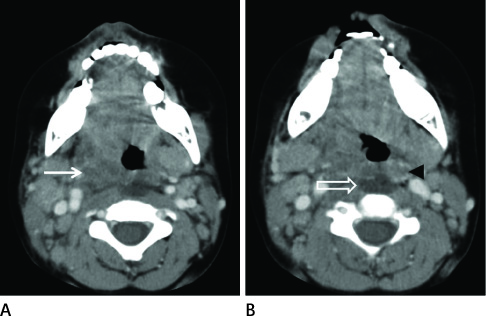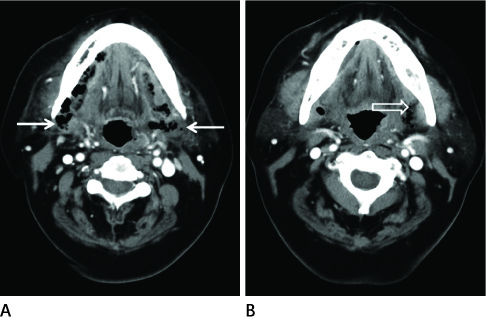J Korean Soc Radiol.
2012 Apr;66(4):309-316. 10.3348/jksr.2012.66.4.309.
A Comparative Study of Deep Neck Abscess with Regards to Anatomical Location and Age Groups Using CT and Clinical Data
- Affiliations
-
- 1Department of Radiology, Soonchunhyang University Cheonan Hospital, Soonchunhyang University College of Medicine, Cheonan, Korea. mdhjk@schmc.ac.kr
- KMID: 2208842
- DOI: http://doi.org/10.3348/jksr.2012.66.4.309
Abstract
- PURPOSE
To evaluate differences anatomical location and age groups on CT and clinical data in deep neck abscess.
MATERIALS AND METHODS
This study included 200 patients who underwent CT and were diagnosed with a deep neck abscess, from December 2005 to July 2010. Patients were divided into four groups by age (children, adolescent, adult, elderly). Next, the anatomic location, location multiplicity and clinical data regarding the deep neck abscesses were analyzed restrospectively. The deep neck abscesses observed were defined as superficial or deep and partitioned into sub-groups, with further analysis of their clinical data.
RESULTS
The incidence of the parapharyngeal abscess was more frequent in children and elderly groups (p < 0.05). The masticator abscess was only observed among patients in the elderly group (p < 0.05). Multiple locations were observed with increased frequecy in children and elderly groups (p < 0.05). Swelling in the neck was more frequently observed in children and elderly groups (p < 0.05), cervical lymphadenitis was frequently seen in children and adolescent groups (p < 0.05), and the incidence of symptoms including sore throat were significantly increased in adolescent and adult groups (p < 0.05). Location multiplicity was significantly higher in parapharyngeal, retropharyngeal, submandibular, danger, visceral and masticator spaces than other spaces (p < 0.05). With regards to anatomic location, neck swelling was more frequent in superficial group and sorethroat was more frequent in deep group (p < 0.05).
CONCLUSION
Deep neck abscess would show significant differences with regards to the abscess location, location multiplicity, and clinical symptoms according to age. The clinical symptoms observed are dependent on the anatomic location as defined by a superficial or deep abscess.
Figure
Reference
-
1. Eftekharian A, Roozbahany NA, Vaezeafshar R, Narimani N. Deep neck infections: a retrospective review of 112 cases. Eur Arch Otorhinolaryngol. 2009; 266:273–277.2. Meher R, Jain A, Sabharwal A, Gupta B, Singh I, Agarwal AK. Deep neck abscess: a prospective study of 54 cases. J Laryngol Otol. 2005; 119:299–302.3. Matzelle SJ, Heard AM, Khong GL, Riley RH, Eakins PD. A retrospective analysis of deep neck infections at Royal perth hospital. Anaesth Intensive Care. 2009; 37:604–607.4. Goo MJ, Yeom JS, Kim EJ, Park JJ, Seo JH, Park ES, et al. Clinical characteristics of deep neck abscess in children; 15 year experience in a university hospital. Korean J Pediatr. 2007; 50:649–654.5. Yang YS, Lee HU, Lee SH, Hong KH. A clinical study of the deep neck infections in children. Korean J Otolaryngol-Head Neck Surg. 2004; 47:1282–1288.6. Cho K, Yoo Y. Clinical characteristics of medically intractable deep neck infection patients. Korean J Otorhinolaryngol-Head Neck Surg. 2009; 52:62–66.7. Daramola OO, Flanagan CE, Maisel RH, Odland RM. Diagnosis and treatment of deep neck space abscesses. Otolaryngol Head Neck Surg. 2009; 141:123–130.8. Parhiscar A, Har-El G. Deep neck abscess: a retrospective review of 210 cases. Ann Otol Rhinol Laryngol. 2001; 110:1051–1054.9. Chang L, Chi H, Chiu NC, Huang FY, Lee KS. Deep neck infections in different age groups of children. J Microbiol Immunol Infect. 2010; 43:47–52.10. Flanary VA, Conley SF. Pediatric deep space neck infections: the Medical College of Wisconsin experience. Int J Pediatr Otorhinolaryngol. 1997; 38:263–271.11. Vieira F, Allen SM, Stocks RM, Thompson JW. Deep neck infection. Otolaryngol Clin North Am. 2008; 41:459–483. vii12. Eom JW. Deep neck infection. J Clin Otolaryngol Head Neck Surg. 2006; 17:31–36.13. McClay JE, Murray AD, Booth T. Intravenous antibiotic therapy for deep neck abscesses defined by computed tomography. Arch Otolaryngol Head Neck Surg. 2003; 129:1207–1212.14. Jović R, Vlaski L, Komazec Z, Canji K. [Results of treatment of deep neck abscesses and phlegmons]. Med Pregl. 1999; 52:402–408.15. Galioto NJ. Peritonsillar abscess. Am Fam Physician. 2008; 77:199–202.16. Do NY, Cho SI, Lee JH, Dong GW, Kim GH. Clinical study of deep neck infection. Korean J Otolaryngol-Head Neck Surg. 2007; 50:240–246.17. Alaani A, Griffiths H, Minhas SS, Olliff J, Lee AB. Parapharyngeal abscess: diagnosis, complications and management in adults. Eur Arch Otorhinolaryngol. 2005; 262:345–350.18. Schuknecht B, Stergiou G, Graetz K. Masticator space abscess derived from odontogenic infection: imaging manifestation and pathways of extension depicted by CT and MR in 30 patients. Eur Radiol. 2008; 18:1972–1979.19. Coticchia JM, Getnick GS, Yun RD, Arnold JE. Age-, site-, and time-specific differences in pediatric deep neck abscesses. Arch Otolaryngol Head Neck Surg. 2004; 130:201–207.20. Craig FW, Schunk JE. Retropharyngeal abscess in children: clinical presentation, utility of imaging, and current management. Pediatrics. 2003; 111:1394–1398.21. Kirse DJ, Roberson DW. Surgical management of retropharyngeal space infections in children. Laryngoscope. 2001; 111:1413–1422.22. Broughton RA. Nonsurgical management of deep neck infections in children. Pediatr Infect Dis J. 1992; 11:14–18.23. Osborn TM, Assael LA, Bell RB. Deep space neck infection: principles of surgical management. Oral Maxillofac Surg Clin North Am. 2008; 20:353–365.
- Full Text Links
- Actions
-
Cited
- CITED
-
- Close
- Share
- Similar articles
-
- Deep cervical space abscess: Role of CT for guiding surgical approach
- A case of Kawasaki disease with coexistence of a parapharyngeal abscess requiring incision and drainage
- Deep Neck Inflammation: Probable Kawasaki Disease in Korean Children
- A Case of Cryptococcal Abscess Involving Deep Neck Space in an Immunocompetent Patient
- Prediction of Location of the Parotid Tumors that Cross Over Anatomical Criteria for Facial Nerve on Computed Tomography




